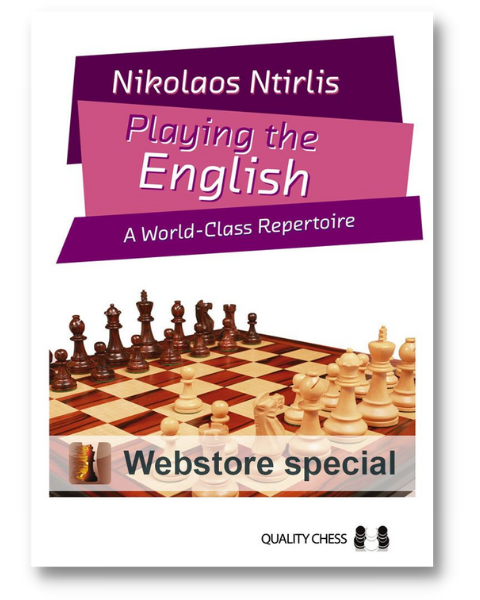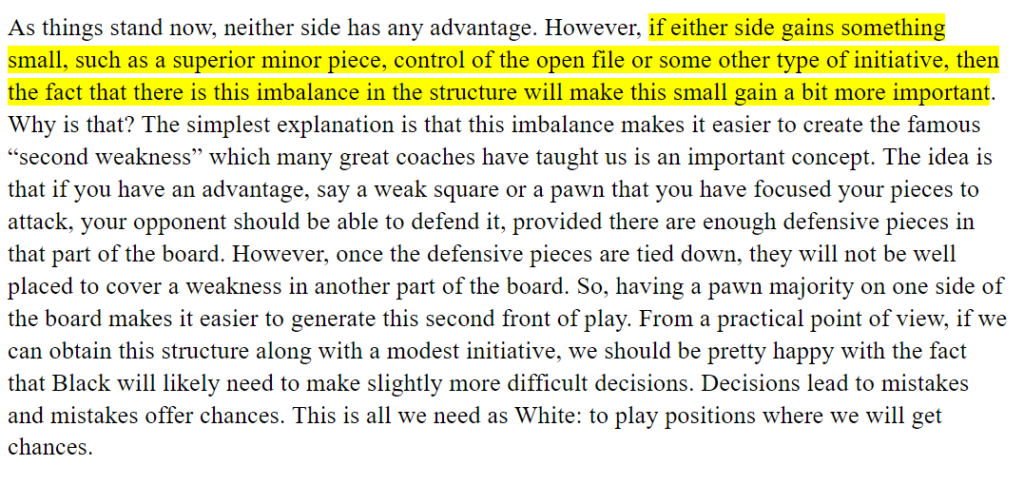The English is a classic chess opening that is a flexible and strategic choice for White, beginning with 1.c4. It focuses on controlling the center and offers interesting pawn structures, preparing for pawn breaks or piece development based on the opponent’s responses. While it can lead to positional maneuvering, it can also transpose into aggressive lines.
The English has been employed successfully by many top players, including Kasparov and Carlsen, adapting well to various playing styles. It suits those seeking dynamic and unexplored positions, making it a compelling option to outmaneuver opponents and create imbalanced positions.
The latest release, Playing the English, by author Nikolaos Ntrilis and Quality Chess offers a full repertoire based on the English with 1.c4. It covers all of Black’s responses and gives the reader straightforward plans and concepts to get a great position out of the opening.

About the Book
Each book section is comprised of the following:
- A variation Index
- An overview of analyzed variations, including tabiyas and model games.
- A short summary that clarifies ideas and the aim of the lines
- A deeper theoretical section that covers all lines
Let’s take a look at the first chapter as an example:
1.c4 e5 Reversed Dragon
Variation Index

Overview
Ntrilis gives the reader the following tabiya overview:
“The first chapter is one of the most important in the book. For many players, when they hear “English Opening”, the first position that comes to mind is this one. As I explained in the introduction, I believe that a great practical way to meet theoretically challenging variations is to deeply study one primary weapon against them, and also have one or two backup ideas that you know to a decent level. This will be exactly our approach in the chapter ahead.”
The reader is not only given analysis of the main variations, but also alternative moves. Such as in the above position; the main recommendation is 8.b3, but attention is also given to 1.d3.
Following this, the reader is given a few common positions and pawn structures that might occur – from the opening to the endgame, and how to approach them. For Example:
Kingside Majority

Theory Section
The first chapter is divided into two main sections based on the recommendations of 8.b3 and 8.d3. This section always starts with an “opening tree” type of structure so that the reader can understand, and refer to, all of the variations covered:

Finally, to really bring one’s understanding of all the theory home, the theoretical chapters end off with a conclusion that reiterates important ideas, plans, and common instances that you will face.
Table of Contents
1.c4 e5
- Reversed Dragon
- Grischuk’s Reversed Dragon
- Reversed Rossolimo
- Other 1…e5 Lines
1.c4 c5
- Pure Symmetry
- Impure Symmetry
- Hedgehog
- Double Fianchetto
Indian Defences
- King’s Indian
- Grunfeld
…d5 Defences
- Slav-Grunfeld
- English vs Slav
- English vs QGD
- Catalan Transposition
Other Defences
- Dutch
- 1…b6 & 1…g6
About the Author

Nikolaos Ntirlis is an acclaimed writer, an opening specialist, and a Correspondence IM with accolades. His experience encompasses serving as an openings consultant for several GMs, including the Danish Olympiad team. He has effectively employed the English Opening in top-tier correspondence tournaments, and delivers exceptional analyses.
Ntirlis has established himself as a prominent chess figure in the field of chess openings, particularly through his written works. He has written books and articles that delve into specific openings, offering in-depth explanations, annotated games, and practical recommendations for players of all levels. His writing style combines meticulous analysis with a clear and engaging presentation, making complex opening concepts accessible and easy to understand.
He has a wealth of experience in writing opening books with successful/ releases such as:
- Playing 1.d4 d5, A Classical Repertoire
- Playing 1.e4 e5 – A Classical Repertoire
- Playing the French
- The Tarrasch Defence
Overall, the English offers a blend of positional and tactical opportunities, appealing to those with diverse playing styles. This book provides the reader with all the variations, ideas, and patterns needed to understand and employ the opening. Emphasis is very much placed on understanding (which we know is more important than memory in opening study!) through repeated motifs, explanations of the types of positions that will come up, model games, and much more.
Have any thoughts or questions? Let us know in the comments below!
Don’t miss out on the special introductory offer at forwardchess.com.
- The Power of Pattern Recognition: The Woodpecker Method 2 - August 20, 2024
- Rock Solid Chess: Volume 2 - February 21, 2024
- Unsung Heroes of Chess - February 19, 2024
